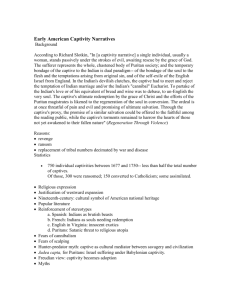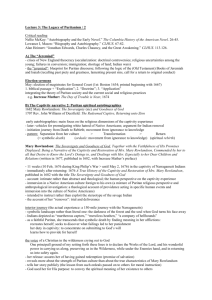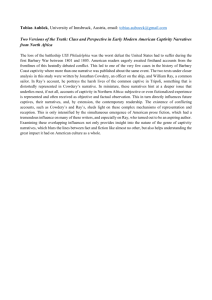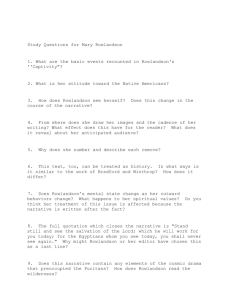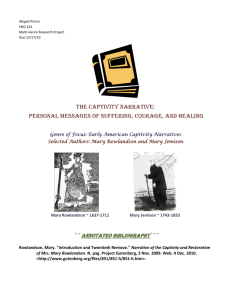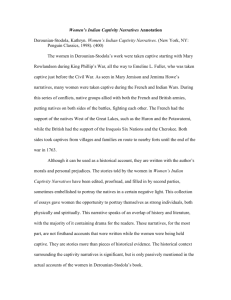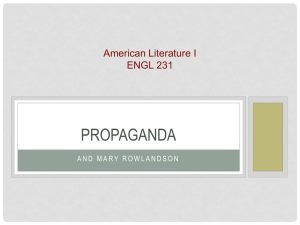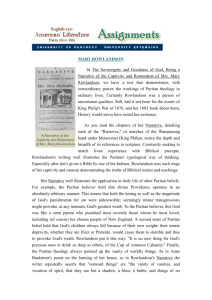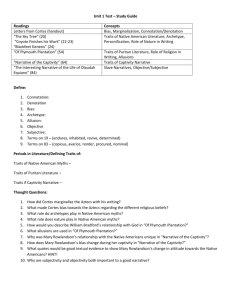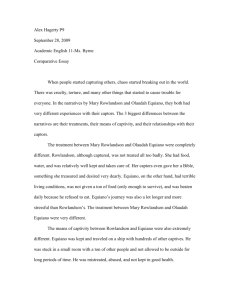Early American Captivity Narratives
advertisement
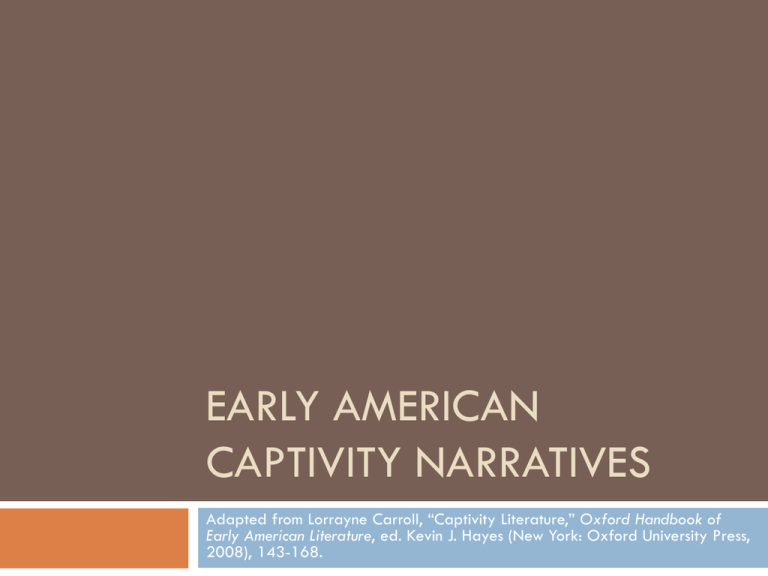
EARLY AMERICAN CAPTIVITY NARRATIVES Adapted from Lorrayne Carroll, “Captivity Literature,” Oxford Handbook of Early American Literature, ed. Kevin J. Hayes (New York: Oxford University Press, 2008), 143-168. Captivity Narratives —general issues and concerns First “new” genre coming out of the American experience Present rich details about ravels in exotic or wild locales and about cross-cultural interactions between European explorers/settlers and indigenous people Variety of forms and modes of dissemination Variety of purposes: conversion narratives, protoethnography, histories/chronicles, sermons, travelogues, political propaganda, personal/psychological narrative Captivity Narratives —general issues and concerns Focus on fear and uncertainty of captive’s position in hostile environment and among hostile peoples Dramatic and personal experiences (rather than more historical/commercial focus of earlier exploration and promotion narratives) Multiple meanings: Authors’ perspectives Relation to church and state (e.g. Puritan New England narrative of Mary Rowlandson vs. Catholic New France narrative of Father Isaac Jogues Context of publication/dissemination Captivity Narratives —general issues and concerns Important focus: varying perspectives on native Americans Tracing changes in Euro-Indian relations NB: COMPLEX NEGOTIATIONS between dominant discourse (colonial government, imperial government, church institutions, etc.) and personal versions and experiences revealed in captivity accounts E.g.: gender roles of women inside home culture and outside that culture (during captivity experience) Captivity as subversive texts? Captivity Narratives and Gender Roles: Subverting or Supporting the Dominant Discourse? Captivity Narratives and Gender Roles: Subverting or Supporting the Dominant Discourse? Captivity Narratives —general issues and concerns Deriving power from image of the suffering captive “redemption”: both temporal/physical and spiritual Interpretation of religious dimensions of captivity were meant to lead readers to spiritual transformation Mary Rowlandson Account published in 1682 (Boston; Cambridge, Mass., London) Full Title: The Sovereignty and Goodness of GOD, together with the faithfulness of his promises displayed; being a narrative of the captivity and restoration of Mrs. Mary Rowlandson, commended by her, to all that desires to know the Lord’s doings to, and dealings with her. Especially to her dear children and relations. … Written by her own hand for her private use, and now made public at the earnest desire of some friends, and for the benefit of the afflicted. Deut. 32.39. See now that I, even I am he, and there is no god with me; I kill and make alive, I would and I heal, neither is there any can deliver out of my hand. Mary Rowlandson Wife of Joseph Rowlandson, minister in Lancaster, Mass. Mary was taken captive on February 10, 1675/76 by Narragansett and Nipmuc raiding party Historical Context: King Philip’s War Six year-old daughter Sarah dies during captivity Daughter Mary and son Joseph also taken captive Later meets Metacom (aka “King Philip”) Is ransomed for 20 pounds Mary Rowlandson Her narrative is considered the inaugural text in the Englishlanguage captivity narrative tradition Establishes many of the conventions of the genre Description of attack Death of young child (often “braining” of babies) Violence of the captors Removes and travels through wilderness/foreign landscape Fears of spiritual and cultural conversion/loss of identity Ethnographic descriptions of captors Suffering of the captive Food/hunger Psychological struggles/developments of the captive Negotiations and redemption/escape Tropes of spiritual/personal/national/cultural/racial/gendered powerlessness and empowerment Mary Rowlandson Context of warfare: Making a general anxiety particular and personal Narrative: trying to give chaotic and painful experience meaning Authenticating devices: - Increase Mather’s preface - Joseph Rowlandson’s sermon appended Initiating the genre’s reliance on psychological commentary Outward suffering and inward turmoil Mary Rowlandson: feminist/gender studies Case study for influence of gender, race, class, on subject’s self-construction One of the first best-sellers in America by a female author Mather’s preface: concerned with framing a woman’s experience within the larger communal, gendered, and religious scripts; text as exemplar of female behavior and spiritual conversion Questions of subversion: critique of home culture and its gendered scripts? Sympathy with/for the captors? “dueling textual voices” (resigned victim vs. resolute/powerful actor) Textual dialogues: observation and interpretation (description/action vs. scriptural passages)


